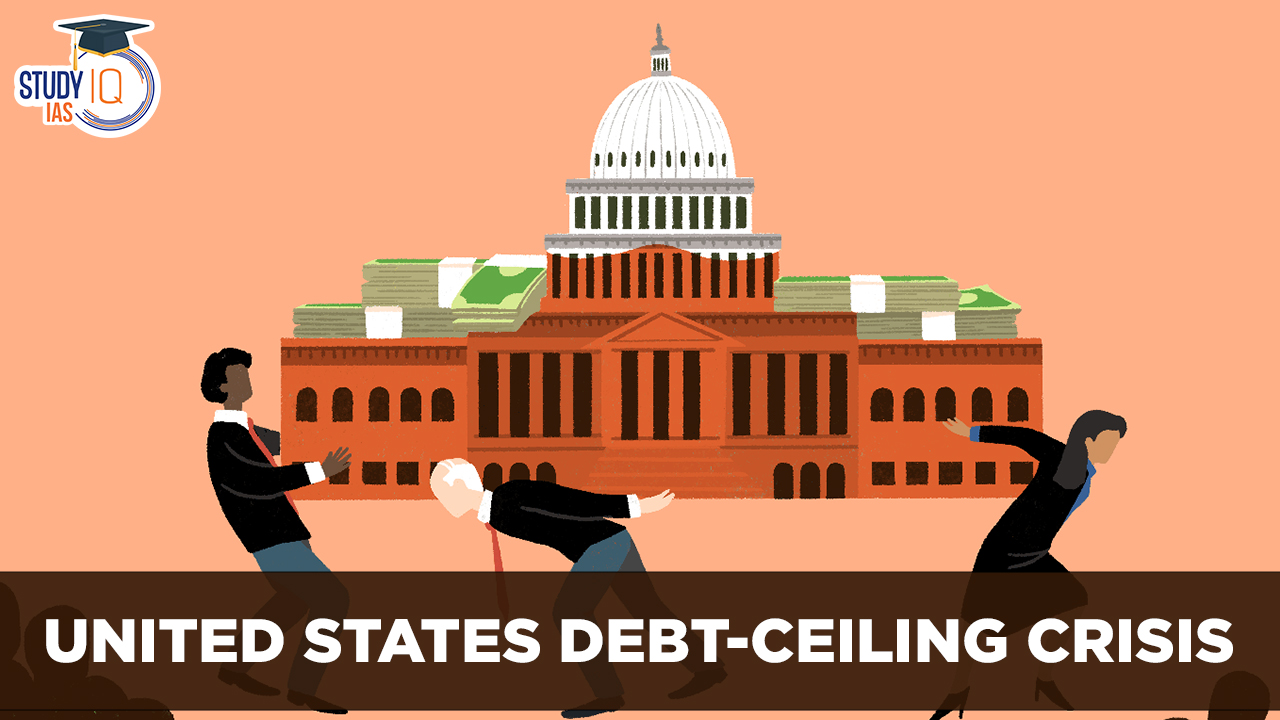Table of Contents
Context: With the ongoing U.S. debt ceiling crisis, finance leaders of the Group of Seven (G7) nations warned for further global economic uncertainty.
Background
- On January 19, 2023, the United States hit its debt ceiling limit of $31.4 trillion, leading to a debt-ceiling crisis.
- Recently, the U.S. Treasury Secretary has notified the U.S. Congress that the country could default on its debt as early as June 1, 2023 if the White House does not reach a consensus to raise or suspend the debt ceiling.
What is the ‘US Debt Ceiling’?
- It refers to the maximum amount of money that the United States government is authorized to borrow to fund its operations and meet its financial obligations.
- It is a legal limit set by Congress on the total amount of outstanding debt that the government can accumulate.
- The debt ceiling was established by the US Congress in 1917 during World War I to make the federal government fiscally responsible.
What happens when the Government reaches Debt Ceiling?
- When the government reaches the debt ceiling, it cannot legally borrow any more funds to cover its expenses.
- At that point, the Treasury Department must employ various measures, known as “extraordinary measures,” to continue financing the government’s operations without surpassing the debt limit.
- These measures can include reallocating funds from other areas, suspending certain government investments, or using accounting techniques to create additional headroom.
- If the debt ceiling is not raised or suspended by Congress, the government may face difficulties in meeting its financial obligations, potentially leading to a default.
Advantages and Disadvantages of the Debt Ceiling
| Advantages | Disadvantages |
| Holds the nation’s finances in check.
Can be used to fund federal operations. Improves efficiency in the government’s ability to fund obligations including Social Security and Medicare benefits. |
Can be easily raised, encouraging fiscal irresponsibility.
Lowers the U.S. credit rating and increases its cost of debt. Controversy over whether the debt ceiling is constitutional. |
What happens if the debt ceiling isn’t raised?
- The most severe consequence of not raising the debt ceiling is the risk of a default by the United States government.
- When the government reaches the debt ceiling, it means it can no longer borrow money to meet its financial obligations, such as paying its debts, Social Security benefits, government salaries, and other critical expenses.
- A default on these obligations would have severe consequences for the economy and financial markets, both domestically and globally.
Implications of US’ defaults on its debt
| Domestic implications for US | Higher borrowing costs: Following a default, the United States would face higher borrowing costs to finance its debt. Higher borrowing costs can dampen investment, discourage borrowing, and hinder economic growth.
Economic recession: The uncertainty and disruptions caused by a default would undermine consumer and business confidence, leading to reduced spending and investment. Government spending would need to be drastically cut, potentially resulting in layoffs, reduced public services, and a contraction in economic activity. Social and political consequences: The cuts in government spending could affect healthcare, education, and social welfare. This could lead to public dissatisfaction and political tensions. |
| Global implications | Economic slowdown: A US default would have ripple effects on the global economy. Export-oriented countries heavily reliant on US demand would be particularly affected.
Financial market contagion: A US default would send shockwaves through global financial markets. Financial institutions around the world that hold US Treasury bonds would suffer losses, affecting their balance sheets and potentially leading to financial instability globally. Currency implications: A US default could undermine confidence in the US dollar as the global reserve currency. This could encourage global de-dollarization efforts. Geopolitical repercussions: It could diminish the United States’ credibility and influence in international affairs, while other countries and blocs may seek to assert themselves on the global stage. |
Past Instances of US Debt Ceiling Crisis
- The US government debt has increased under every single president since 1929, resulting in the debt ceiling being raised over 100 times, with occasional instances of suspension that have contributed to crisis-like situations.
- In 2011: The US reached a crisis point of near default on public debt and suspended the rise in the limit. The delay in raising the debt ceiling led to its first downgrade in the US credit rating, a sharp drop in the stock market, and an increase in borrowing costs.
- Another one in 2013: This time when the ceiling was reached again, the Treasury adopted extraordinary measures to delay a default. These measures included suspending investments in individual retirement funds of federal employees, the Civil Service Retiree’s and Disability Fund, the Postal Service Retiree Health Benefits Fund, etc.
- That apart, the debt ceiling was suspended in 2015, 2017, and 2019, but in all these years it was upwardly revised post a few months of suspension.
Does India have a Debt Ceiling Mechanism?
- India does not have a formal debt ceiling mechanism similar to the one in the United States.
- The Indian government manages its borrowing and debt obligations through various measures, including fiscal discipline, budgetary controls, and oversight by the Reserve Bank of India (RBI).
- In India, the government’s borrowing activities are governed by the provisions of the Fiscal Responsibility and Budget Management (FRBM) Act, which sets targets for fiscal deficits and debt-to-GDP ratios. The FRBM Act aims to ensure prudent fiscal management and fiscal discipline by the government.


 SSC CGL Exam 2025 Apply Online Starts Ap...
SSC CGL Exam 2025 Apply Online Starts Ap...
 Daily Quiz 19 April 2025
Daily Quiz 19 April 2025
 Vehicle-to-Grid (V2G) Technology and its...
Vehicle-to-Grid (V2G) Technology and its...





















